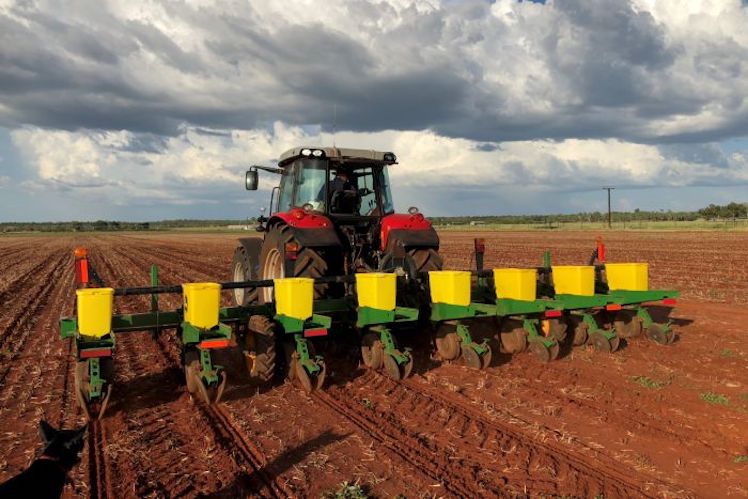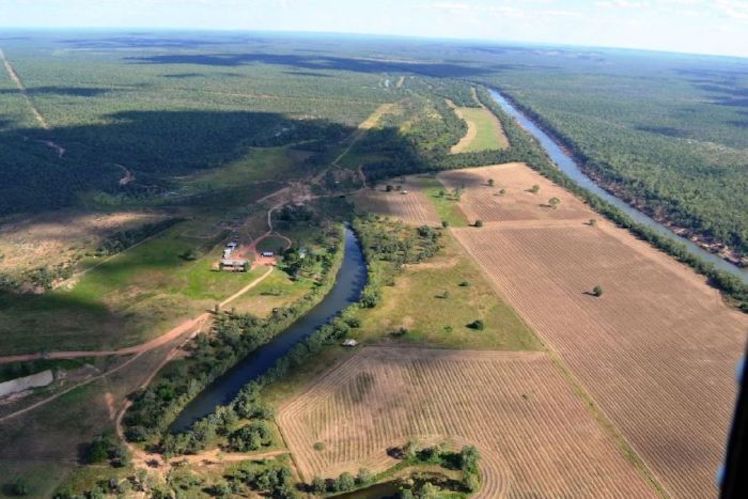Water chasers are eyeing off the wild rivers of Northern Australia. They have been galvanised by federal government development and water policy; by demand for agricultural produce in Asia; by the southern drought; by developments in the cotton industry; and by good old-fashioned profiteering. Triskele reports.
The chase for water is not just about cotton, but cotton is emerging as a central actor. Headlines such as “The Next Cubbie Station, China’s $400 million investment in northern Australia” reflect some of the excitement that the emerging northern cotton industry is producing in some, and inevitably will send shivers down the spines of others.
Cotton the new base crop for Northern Australia?
The first successful harvests of two commercial cotton trial crops at Tipperary and Edith Springs Stations in the Northern Territory this year have unleashed constant enquiries from southern cotton growers and international growers who were waiting for the results from Tipperary and the Ord to “see if they might try and come into the area.” David Connolly, General Manager of Tipperary Station, stated “Our roads turn dusty from people in the south driving up here to have a look….It’s created an incredible amount of interest”. Andrew Philip, from the NT Farmers Association, reported that
“…the biggest range of investors we’re seeing are family companies from the eastern states – Queensland, New South Wales, Victoria – that have basically become land-locked, haven’t been able to expand their cotton enterprises, and are looking at the next place to go.”
NT croppers have formed a new cotton industry group. The Western Australian government’s Water for Food program is an irrigated agriculture development program, inclusive of cotton. Large farm areas in the in Gulf of Carpentaria in North Queensland are being prepared for cotton as the base crop. The future for cotton looks bright.

Trial crop of cotton at Katherine Research Station, NT. (Image courtesy Department Primary Industry)
Cotton has frequently received a bad rap in this drought-stricken country, as the cotton industry is always quick to point out. Cotton is a very useful perennial crop which can provide quick returns to farmers and be a useful adjunct on diversified farms. Genetically modified seeds have greatly improved its water efficiency and with Monsanto’s Bollgard 3, also its resistance to pests.
Nevertheless, historically, cotton in Australia has been much more connected to corporate agribusiness than to small farming operations, and its success has depended upon access to cheap water distributed via government water allocations. In practice, the cotton industry in Australia is capital and not labour intensive; has been involved in malfeasance and mismanagement of water, contributing enormously to collapse of the Murray-Darling basin; and has been regularly at the centre of political scandal. This is the context behind calls for cotton to be banned altogether in Australia.
Watergate: An ecosystem cultivated for sharks won’t support goldfish
Cotton expansion is being driven by government and big agribusiness, particularly from Asia. However, the success of cotton in Northern Australia is contingent on the building of a cotton gin which significantly lowers transport costs; and the success of the gin is contingent on the production of a sufficient volume of cotton.
Enter Kimberley Agricultural Investment (KAI)
Kimberley Agricultural Investment (KAI) is the wholly-owned Australian subsidiary of the Chinese-based Shanghai Zhongfu Group, chaired by its majority shareholder, the billionaire property developer Pui Ngai Wu. It is aiming to be one of Australia’s biggest irrigated farms and become an operation to rival Queensland’s Cubbie station within a decade. KAI is building an irrigation district in the Ord River in the eastern Kimberley, and the vision is to build an entire region which will be central to the vision of the north as a food bowl for Asia. It has already invested more than $300 million in the East Kimberley, and the WA government is anticipating a projected investment in the Ord of more than $1billion.
This extraordinary level of investment will be sustained by cotton. As Jim Engelke, general manager of KAI put it, “Cotton is the enabler of everything”. While the cotton fibre will be exported, the residual cotton seed has additional value as protein for cattle. Cotton therefore forms a part of an “integrated but diversified model” of agriculture, in which “farmers will loosely cooperate to develop an industry built around cotton, feed crops and cattle”.
Success will depend on how quickly KAI can achieve scale, so speed is of the essence. KAI planted 350 hectares of experimental cotton crops in 2018, the first commercial wet season cotton crop planted in the Ord Irrigation Scheme since the industry collapsed in the 1970s. According to the WA government, KAI expects to plant several thousand hectares of cotton crops in 2020, aiming at 12,000 hectares within a decade.
Crucially, KAI is also planning to build a cotton gin, costing upwards of $30 million.
KAI has had a galvanising effect on the entire industry. Big corporates and opportunistic newbies alike appear to be eyeing the possibilities. In January this year, a Vietnamese investment company bought three cattle stations in the NT and WA and expressed a desire to diversify into cotton. KAI is also reportedly encouraging other producers to move into cotton, such as the Hu family, a large cotton growing family from the north-west of China, which bought Florina Station (west of Katherine) in 2016. They are running cattle, but were reportedly hoping to grow 5,000 hectares of cotton at Florina Station.
An intriguing recent arrival is that of the new owners of Flying Fox Station, who are also currently running cattle, but according to one ABC report “have expressed an interest in investigating the potential of cotton.” Flying Fox Station was bought in November 2018 by Kupang Agricultural Management, which had only been registered in Sydney three months earlier, and which is itself owned by Kupang Agricultural BV Limited, situated in the notorious tax haven of the British Virgin Islands.
Meanwhile, the South Australian government has announced its intention to terminate the current ban on genetically modified crops, which opens up the South Australian Riverland, currently known for production of citrus and wine, to cotton production.
Develop and be “dammed”
One key enabler is the federal government, which is leading ambitious and bold long-term aims to succeed where earlier nation-building development projects in the north have failed. In 2015, the Australian government released two key White Papers on developing Northern Australia and agricultural competitiveness. The government then commissioned the CSIRO to complete a 2.5-year, $15-million Northern Australia Water Resource Assessment, completed at the end of June 2018. The focus of the Assessment is mainly on the potential for development of agriculture and aquaculture in the Fitzroy, Darwin, and Mitchell catchments.
The federal government committed $5 million to expanding the irrigation zone in the East Kimberley (Ord Stage 3), despite the WA auditor-general finding disappointing results in earlier attempts which resulted in the waste of public money.
The KAI cotton project is being run under a $11.7 million project by the Northern Australia Crop Research Alliance, funded by the federal government and a number of private stakeholders including KAI. A feasibility study into building a cotton gin in Katherine is being funded by Singapore agribusiness OLAM (owners of Queensland Cotton), the Northern Territory Cotton Growers Association, and the NT government.
Irrigation developments are also framed and enabled by water infrastructure projects. As part of its commitment to getting key water infrastructure constructed up north, state and Territory governments are able to apply for capital funding grants from the National Water Infrastructure Development Fund budget of $2.4 billion, and can also access $440 million from the capital component of the Fund, as well as from the $2 billion National Water Infrastructure Loans Facility.
There is also the $5 billion available in the Northern Australia Infrastructure Facility (NAIF). Although there are currently no irrigation infrastructure projects on the NAIF website, a Western Australian government report notes that “KAI is in discussions with the Northern Australia Infrastructure Facility regarding investment of between $30 to $40 billion into operations in the Ord”. Ironically, this is about the figure that would be required to build a cotton gin.
The rollout of the National Water Grid (a statutory authority set up to oversee building of sometimes controversial projects for water diversion and storage) is the final piece of the development architecture.
Tandou Can Do: double standards in water purchases in the Murray-Darling Basin
Who benefits?
The water chasing raises the spectre of repeating the mistakes of the Murray-Darling Basin.
Is this development, or are all the drivers in place for a water grab?
Current government policy is still firmly anchored in the language of eternal growth. As John Williams has noted, it is also still tragically anchored in “the same myths and false beliefs [about “wasting water”, “making the desert bloom” and “drought-proofing”] that got us into trouble in the first place.” Twentieth century approaches to development are represented as the only game in town, when as research from the University of South Australia and The Australia Institute show other developmental models exist but are ignored.
Meanwhile, according to the Productivity Commission, WA and the NT are lagging in implementing the water reforms demanded of them under the National Water Initiative. The CSIRO report on the state of water regulation across the north suggests water planning is as yet under-developed in WA and the NT, particularly around protecting indigenous interests.
The CSIRO’s job was broadly to identify the degree of water harvesting that might take place to support irrigated agriculture in the north, but in doing so, carefully noted that social licence is crucial.
Fearing that this could be the next Murray-Darling saga, traditional owners on the Fitzroy River have already asked for a pause on the development of water allocation plans. Meanwhile, N.T farmers and fishers have also rejected a federal government proposal to dam Northern Territory rivers to create a “super food bowl”, with one farmer telling Canberra:
“They’ve completely stuffed their own water management plans. We don’t need their opinions up here.”
At heart, this is a project involving harvesting water from wild rivers and floodplains, in times of drought, to pursue 1950s throwback approaches to big development in irrigated agriculture, by big business, for export to Asia. At stake are the water resources of the north. The big question is whether this is a story about rivers of life, or rivers of money.
———————
From Visionary to Venal: what went wrong at the Murray-Darling Basin Authority
Public support is vital so this website can continue to fund investigations and publish stories which speak truth to power. Please subscribe for the free newsletter, share stories on social media and, if you can afford it, tip in $5 a month.
The above investigation is published anonymously at the author’s request. Triskele’s identity and bona fides are known to us. Triskele is an academic and journal editor as well as independent researcher interested in politics, history, current affairs, books, languages, and “all things nerdy”.
